PUBLISHER: SNE Research | PRODUCT CODE: 1604918

PUBLISHER: SNE Research | PRODUCT CODE: 1604918
<2025> Development Status and Outlook of Binder Technology for Secondary Batteries (~2035)
The characteristics of LIBs are largely determined by the electrodes, and optimizing the electrode structure is the top priority in order to achieve excellent battery performance. While the active materials of the cathode and anode are being studied and reviewed with much interest not only in currently commercialized LIBs but also in the research field, the inactive binder that does not participate in the electrode reaction maintains the integrity of the electrode with a low weight ratio (less than or equal to 5 wt%) and supports the electrochemical process, and occupies an important position in terms of implementing the performance of the electrode along with the active material and the conductive agent, but it is receiving less attention compared to its importance.
The binder occupies a very small portion of the electrode but plays a crucial role in determining the overall performance of the electrode. It helps active materials and conductive agents in both the cathode and anode adhere firmly to the current collector while enhancing durability. A binder must be (1) electrochemically stable in the electrolyte, (2) possess flexibility and insolubility, and (3) specifically for cathode binders, provide corrosion resistance against oxidation.
Therefore, a functional binder with high bonding strength and elasticity is required to effectively connect the active material and conductive agent to the current collector, accommodate volume expansion, and ensure a stable electrode structure during charge and discharge cycles. Recently, with deeper insights into binder screening and design, research has been shifting its focus from merely serving as a structural support for mechanical stabilization to developing multifunctional binders that also provide electrochemical advantages.
Recently, with the increasing adoption of silicon anode materials, research has shown that binders significantly influence the lithiation reaction, contributing to improved electrode capacity and cycle stability. This has led to active advancements in next-generation binder development. Traditionally, fluoropolymer-based PVDF (Polyvinylidene Fluoride) has been primarily used as a binder for cathodes, while SBR (Styrene-Butadiene Rubber) and CMC (Carboxymethyl Cellulose) have been used for anodes. However, due to the significant volume expansion of silicon anodes, these conventional binders are unsuitable for use with silicon-based materials.
Recently, PTFE (PolyTetraFluoroEthylene) binders have been gaining attention for cathodes, while water-based binders such as PAA (PolyAcrylic Acid) and PI (PolyImide) are increasingly used for anodes. These water-based binders are particularly suitable for silicon anodes, which utilize water-based solvents as electrolytes. Compared to conventional binders, PAA and PI offer higher tensile strength and stronger adhesion, making them more resistant to the volume expansion of silicon anodes. Additionally, these binders encapsulate the active material, helping to form a stable SEI (Solid Electrolyte Interphase) layer, which enhances electrode stability and cycle performance.
The next-generation cathode binder, PTFE (PolyTetraFluoroEthylene), is a binder for dry electrode processes. As a highly hydrophobic material with excellent chemical and thermal resistance, it is expected to gain attention for use in dry electrode processes and solid-state batteries.
PVDF binders are produced by Kureha (Japan), Solvay (Belgium), and Arkema (France), while SBR binders are manufactured by Zeon (Japan), making them high-cost materials with a high reliance on foreign suppliers.
For cathode binders, Chemtros (South Korea) has successfully localized production, while for anode binders, Hansol Chemical (South Korea) has also achieved domestic production and is supplying to Samsung SDI and SK On. Additionally, LG Chem and Kumho Petrochemical are entering the anode binder supply market.
According to SNE Research's global demand forecast for lithium-ion battery binders as of November 2024, the market is expected to grow from 181.2 kton in 2025 to 311.4 kton in 2030. In terms of value, it is projected to increase from KRW 4.4 trillion in 2025 to KRW 6.11 trillion in 2030.
The 2024 edition of the report has been enhanced with a particular focus on solid-state batteries and sodium-ion batteries, which have recently become hot topics. It includes thermal and dispersion properties of binders for these next-generation batteries and provides additional insights into the operational mechanisms and failure mechanisms of binders to improve understanding. Additionally, the report presents a chronological compilation of research on binder design, synthesis, and application in lithium-ion battery electrodes, covering all relevant literature published to date. For those seeking deeper technical details, references to the original papers have been included, allowing for further exploration of the subject.
Based on our lithium-ion battery market outlook, we have projected the demand and market trends for binders. In the appendix, we have included market size estimates and forecasts from external research institutions to help readers gain a comprehensive understanding of the overall market scale. For key binders such as PVDF, SBR, and CMC, the report includes detailed market data from 2021, 2022, and 2023, along with forecasts for 2024, providing a clear view of demand trends over time.
Finally, by compiling the most recent status and key products of binder manufacturers in 2024, this report aims to provide comprehensive insights for researchers and industry professionals. It is expected to contribute significantly to improving battery performance, including energy density, fast-charging capability, and long-term cycle life.
Strong Points of This Report :
- 1. Comprehensive overview and detailed technical content on binders
- 2. Key design and synthesis considerations derived from binder development case studies
- 3. Analysis of binder development trends and case studies for next-generation batteries, including Li-S batteries, solid-state batteries, and sodium-ion batteries (SIBs), in addition to LIBs
- 4. Binder market outlook based on SNE Research's battery forecasts, along with data on the binder market for LFP batteries
- 5. Detailed information on the latest developments and product status of major binder manufacturers
[PVDF Binder Manufacturers' Shipment Volume and Market Share (M/S)]
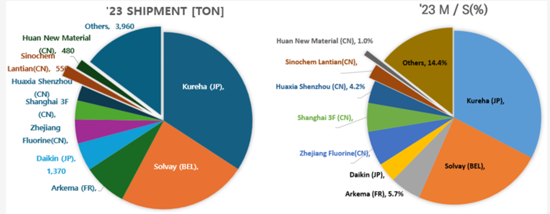
[SBR Binder Manufacturers' Shipment Volume and Market Share (M/S)]
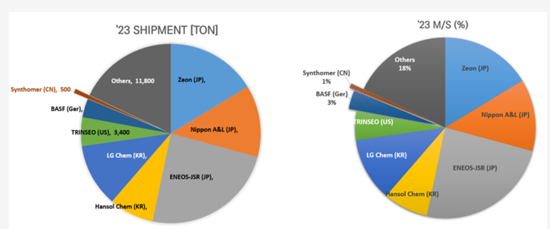
Global LIB Binder(Cathode + Anode) Demand Forecast (kTon)
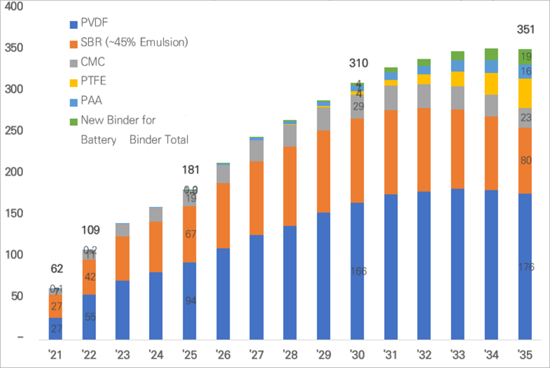
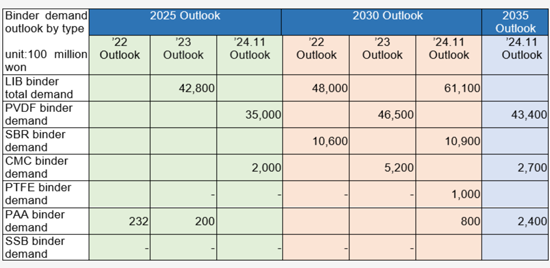
[Tesla 4680 Battery Binder Cost Analysis]
- Cathode: NCM811, Anode: Si-based
- PVDF cathode binder requirement and cost for 1 GWh battery: around 38 tons
- PAA anode binder requirement and cost for 1 GWh battery: around 24 tons
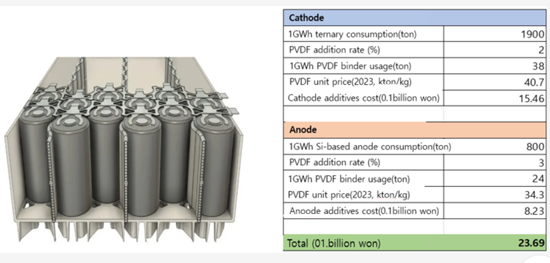
Table of Contents
1. Binder Overview
- 1.1. Introduction
- 1.2. Definition, Role, and Requirements
- 1.2.1. Role and Features
- 1.2.1.1. Mechanical Properties
- 1.2.1.1.1. Improvement of Adhesion and Mechanical Strength
- 1.2.1.1.2. Control of Volume Change
- 1.2.1.2. Mitigation of Interface Performance Degradation
- 1.2.1.3. Electrical Properties
- 1.2.1.3.1. Improvement of Electrical Conductivity
- 1.2.1.3.2. Improvement of Ion Conductivity
- 1.2.1.4. Thermal Properties
- 1.2.1.4.1. Improvement of Thermal Stability and Wide Temperature Operation Range
- 1.2.1.5. Dispersion Properties
- 1.2.1.5.1. Improvement of Electrode Homogeneity
- 1.2.1.1. Mechanical Properties
- 1.2.2. Requirements
- 1.2.1. Role and Features
- 1.3. Categories and Types
- 1.3.1. Types
- 1.4. Operation Mechanism
- 1.5. Binder Failure Mechanisms
- 1.6. Advanced Strategies for Binder Development
- 1.6.1. Improvement of Mechanical Bonding Strength
- 1.6.2. Improvement of Chemical Bonding Strength
- 1.6.3. Design of Multifunctional Integrated Binders
- 1.7. Binder Characterization Techniques
- 1.7.1. Evaluation of Binder Distribution and Composition in Cathode
2. Types of Binders and R&D Practices
- 2.1. Binder for Cathodes
- 2.1.1. Non-Aqueous Binders
- 2.1.2. Industry Status of PVDF Cathode Binders
- 2.1.3. Industry Status of (CMC+SBR) Anode Binders
- 2.1.4. Water-based Binders
- 2.1.5. Other Binders
- 2.1.5.1. Conductive Polymer
- 2.1.5.1.1. Polyacrylonitrile(PAN)
- 2.1.5.1. Conductive Polymer
- 2.2. Binders for Anodes
- 2.2.1. Insertable Anode Binder
- 2.2.1.1. Binders for Graphite Electrodes
- 2.2.1.2. Anode Binder for LTO
- 2.2.2. Alloy Anode Binders
- 2.2.2.1. Linear Polymer Binders
- 2.2.2.2. Crosslinked Polymer Binders
- 2.2.2.3. Branched and Extra-Large Polymer Binders
- 2.2.2.4. Conductive Polymer Binders
- 2.2.1. Insertable Anode Binder
- 2.3. Binder for Next-Generation Batteries (1)
- 2.3.1. Binders for Lithium-Sulfur (Li-S) Batteries
- 2.3.2 (4680)Binders for Dry Process
- 2.3.3. Binders for Sodium-Ion Batteries (SIB)
- 2.3.3.1. Development of Binders for SIB
- 2.3.3.2. Conventional Binders
- 2.3.3.2.1. PVDF
- 2.3.3.2.2. PAA
- 2.3.3.2.3. SA(Sodium Alginate)
- 2.3.3.2.4. CMC
- 2.3.3.3. New Binders
- 2.3.3.3.1. Conductive Binders
- 2.3.3.3.2. Cross-linking Binders
- 2.3.3.3.3. Self-healing Binders
- 2.3.3. Binders for Sodium-Ion Batteries (SIB)
- 2.4. Binder for Next-Generation Batteries (2)
- 2.4.1. Binders for Solid Electrolytes
- 2.4.1.1. Overview of All-Solid-State Batteries
- 2.4.1.2. Sulfide-based All-Solid-State Battery Technology
- 2.4.1.3. Manufacturing of All-Solid-State Cells and the Purpose of Binders
- 2.4.1.4. Binder Technology for Cathodes
- 2.4.1.4.1. Binder Technology for Wet Processes
- 2.4.1.4.2. Binder Technology for Dry Processes
- 2.4.1.5. Binder Technology for Electrolyte Layers
- 2.4.1.6. Binder Technology for Anodes
- 2.4.1.6.1. Binder Technology for Graphite-Based Anodes
- 2.4.1.6.2. Next Generation Binder Technology for Anodes
- 2.4.1. Binders for Solid Electrolytes
3. Binder Market
- 3.1. Overall Outlook for the Binders Market(Outlook by Other Researchers)
- 3.2. PVDF Market Outlook for Global LIBs
- 3.2.1. Global Battery Market Demand Outlook
- 3.2.1.1. Global LIB Demand Outlook by Form Factor (GWh, %)
- 3.2.1.2. Global LIB Cathode Material Demand Outlook (GWh, k ton)
- 3.2.1.3. Global LIB Anode Material Demand Outlook (k ton)
- 3.2.2. Global LIB Binder Demand Outlook
- 3.2.3. LIB Binder Price Outlook
- 3.2.4. LIB Binder Market Size Outlook
- 3.2.5. Global Cathode Binder Demand Outlook by Major Battery Companies
- 3.2.6. Global Anode Binder Demand Outlook by Major Battery Companies
- 3.2.7. Market Outlook for Binders for Silicon-based Anodes
- 3.2.8. PAA Binders for Silicon Anode Market Outlook
- 3.2.9. Global LFP Binder Demand Outlook (k ton)(CAGR 12%)
- 3.2.10. Binder cost analysis for 4680 batteries for Tesla
- 3.2.11. Shipments and M/S of LIB Binder Manufacturers
- 3.2.12. Shipments and M/S of PVDF Binder Manufacturers
- 3.2.13. Shipments and M/S of SBR Binder Manufacturers
- 3.2.14. Shipments and M/S of CMC Binder Manufacturers
- 3.2.1. Global Battery Market Demand Outlook
4. Binder Manufacturer Status
- Arkema Group
- BASF SE
- Solvay
- Kureha Corp.
- ZEON Corp.
- JSR Corp.
- Fujian Blue Ocean Co. Ltd (BLUE OCEAN & BLACK STONE)
- Dupont (CMC)
- Ashland Inc.
- MTI Corp.
- TRINSEO
- Xinxiang Jinbang Power Technology Co., Ltd.
- Chongqing Lihong Fine Chemical (CMC Binder Manufacturers)
- Chemtros
- Hansol Chemical
- Kumho Petrochemical
- Daikin Industry
- Nanografi Nano Technology
- Nippon Paper Group
- APV Engineered Coatings LLC
- Sichuan Indigo Materials Science & Technology (INDIGO)
- Guangzhou Songbai Chemical Co (Songbai)
- Nippon A&L Inc.
- Daicel Miraizu Ltd.
- Sinochem Group Co.
- Ube Corp.
- AOT Battery Equipment Technology
- Shanghai Huayi 3F New Materials
- GL Chem
5. Appendix[For reference](Analysis of binder cost for water-based cathodes, etc.)
6. References




